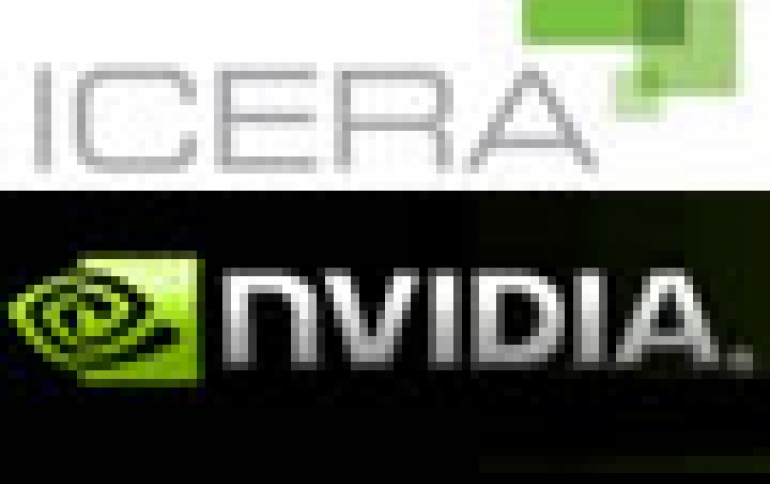
NVIDIA To Showacase Icera Modems At MWC 2012
Nvidia will be giving a sneak peek at technologies developed by Icera, the UK company NVIDIA acquired in mid-2011 at next week's Mobile World Congress (MWC) show.
Nvidia will be showing the NVIDIA Icera 410 LTE modem, showcasing the latest advances in Voice over LTE (VoLTE), as well as multiplayer gaming over a live LTE network.
For VoLTE, Nvidia will demonstrate handover of voice calls from an LTE network to a circuit-switched WCDMA 3G network, and vice versa, using Single Radio Voice Call Continuity (SRVCC) with HD quality voice (known in the industry as AMR-WB or Adaptive Multi-Rate-Wideband).
SRVCC is a technology that enables voice calls to hop between 4G and 3G networks, which will exist side by side for some time. It's important because it marks a significant step towards operators being able to move their voice traffic from 3G to LTE networks, allowing the 3G spectrum to be re-used for super-fast LTE technology.
It relies on a single radio in the handset for hand-off and a single multimode baseband processor to support LTE VoIP and circuit-switched 3G - like the Icera LTE modem - rather than different basebands for each air interface. What's more, using a single multimode baseband also means smaller phone designs, lower power and better battery life.
Nvidia is also showing a live LTE gaming demo at its booth (Hall 1, Stand C34), using its software defined radio (SDR) modem that implements all three radio technologies - 4G, 3G and 2G - with the full handover capabilities that network operators will need next year. The NVIDIA Icera modem is currently used more than any other modem to validate LTE handover test cases designed to meet the requirements set by global standards organisations. This means users will experience a smooth connection, regardless of whether they are using an LTE, 3G or 2G network.
The NVIDIA Icera LTE modem leverages the company's SDR technology, which enables software upgradable functions to OEMs and carriers.
Nvidia's roadmap for 2012-2013 includes a bevy of wireless data technologies, including: LTE FDD, TD-LTE, 42Mbps Dual Carrier and TD-SCDMA in addition to existing HSPA+, HSPA and 2G technologies.
Nvidia acquired Icera, an innovator of baseband processors for 3G and 4G cellular phones and tablets last year.
For VoLTE, Nvidia will demonstrate handover of voice calls from an LTE network to a circuit-switched WCDMA 3G network, and vice versa, using Single Radio Voice Call Continuity (SRVCC) with HD quality voice (known in the industry as AMR-WB or Adaptive Multi-Rate-Wideband).
SRVCC is a technology that enables voice calls to hop between 4G and 3G networks, which will exist side by side for some time. It's important because it marks a significant step towards operators being able to move their voice traffic from 3G to LTE networks, allowing the 3G spectrum to be re-used for super-fast LTE technology.
It relies on a single radio in the handset for hand-off and a single multimode baseband processor to support LTE VoIP and circuit-switched 3G - like the Icera LTE modem - rather than different basebands for each air interface. What's more, using a single multimode baseband also means smaller phone designs, lower power and better battery life.
Nvidia is also showing a live LTE gaming demo at its booth (Hall 1, Stand C34), using its software defined radio (SDR) modem that implements all three radio technologies - 4G, 3G and 2G - with the full handover capabilities that network operators will need next year. The NVIDIA Icera modem is currently used more than any other modem to validate LTE handover test cases designed to meet the requirements set by global standards organisations. This means users will experience a smooth connection, regardless of whether they are using an LTE, 3G or 2G network.
The NVIDIA Icera LTE modem leverages the company's SDR technology, which enables software upgradable functions to OEMs and carriers.
Nvidia's roadmap for 2012-2013 includes a bevy of wireless data technologies, including: LTE FDD, TD-LTE, 42Mbps Dual Carrier and TD-SCDMA in addition to existing HSPA+, HSPA and 2G technologies.
Nvidia acquired Icera, an innovator of baseband processors for 3G and 4G cellular phones and tablets last year.





















